Installation of copper heating pipes: features of the technology of work
Despite the appearance on the market of inexpensive and practical materials, copper pipes are still successfully used for the assembly of internal wiring of heating circuits. But copper is an expensive material, so the installation of copper heating pipes should be carried out by carefully studying the rules and regulations.
The efficiency of the finished system depends on the quality of the equipment and on the skill of making the connections.
Let's look at the features of copper pipelines for heating and the technology of their installation together.
The content of the article:
Differences in copper piping for heating
Copper has a whole range of positive qualities, thanks to which it stands out from the rest of the materials. If the construction project allows the use of such expensive elements, then for the internal wiring of the heating system, you should purchase a kit copper pipes and fittings in the amount hammered in the estimate.
Pluses of copper pipelines:
- the ability of the metal to expand allows you to easily tolerate the high temperature of the coolant, sudden temperature jumps and even freezing of water;
- for the same reason, copper perfectly withstands pressure drops in the network, as well as possible water hammer;
- the reddish metal is resistant to hard water containing impurities - lime, chlorine, etc .;
- the material does not have perfect smoothness of the inner walls, but a low degree of roughness protects against the formation of limescale and creates little resistance to the movement of the coolant;
- copper is known for resisting the development of pathogenic bacteria and the formation of mold;
- the combination of strength and softness allows you to create pipelines of various designs;
- in some cases, the heating wiring performs a decorative function, although safer copper circuits of the HVS or gas pipeline are recommended for room decoration.
To prevent foreign matter from being deposited on the pipes and not reducing functionality, special requirements are placed on the coolant: the water must be clean, filtered.
But copper pipes also have their drawbacks, the main of which is the high cost. If we take for comparison two meter pipes with a diameter of 26 mm made of metal-plastic and copper, the first will cost 147 rubles, and the second - 486 rubles. It turns out that the copper wiring will come out more than 3 times more expensive.
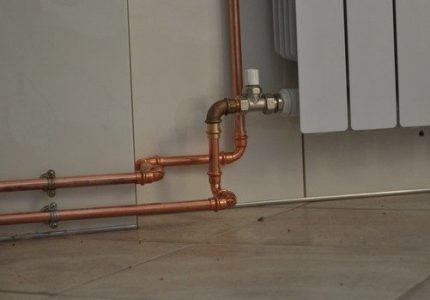
Copper is selective for other metals, so fittings should be selected carefully. Aluminum, duralumin or steel parts cause an electrochemical reaction and rapid corrosion.
Therefore, usually use either "native" copper connectors, or brass, bronze, chrome or nickel. Pin tin or solder is used only in the soldering process.
Pipe Regulatory Requirements
If copper as a material is completely satisfied and the cost of the products does not bother, it is necessary to check the compliance of all system components with state standards.
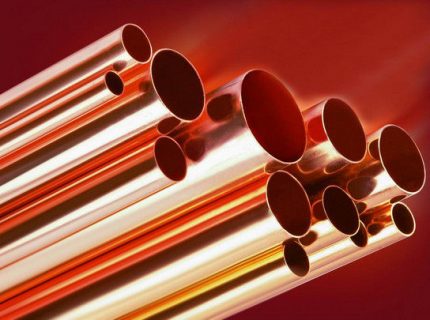
Documents governing the installation of wiring are also useful - STO NP “AVOK” 6.3.1–2007 “Pipelines of copper pipes ...” and SP 40–108–2004 "Design and installation ...". The requirements for product range, the composition of the coolant, the characteristics of the pipes.
Data tables and graphs will help with the selection of solders. Material about anticorrosion protection, repair work and calculation methods may be useful.
Technologies and rules for installation
To begin, consider the general rules regarding the installation of copper pipelines. As you know, metal is an excellent conductor. To provide protection against stray currents, as well as reduce the risk of corrosion, you can use products in a polymer shell.
In private practice, it is quite rare, but in industry assembly of pipelines from steel and copper is still used. In this case, it is recommended that steel be used for risers, and copper - for wiring, that is, steel products should be in the first position according to the flow of coolant. Magnesium connectors are required.
There are several ways to connect products, the choice of each of them depends on the specific situation:
- capillary soldering with solder;
- compression fittings;
- pressed fittings;
- threaded installation.
The latter method is practically not used, because it has lost its relevance.Soldering and crimping are distinguished by the degree of complexity, the technique of execution, the presence of different tools, but are equally in demand. Consider three popular piping technologies.
How to connect pipes by capillary soldering?
Soldering takes longer, however, the joints made are durable and leakproof. The best option for solving everyday problems is the use of soft solder. The operating temperature does not exceed 250 ° C.
The use of solder increases the strength, but expensive equipment and special conditions will be required for work, since the soldering process takes place at a temperature of more than 700 ° C.
With the help of soldering, one-piece joints are created, which are performed either by a bell-shaped method or by means of fittings. With bell-shaped technology, one end of the pipe must be expanded so that when the elements join, a gap of 0.2-0.3 mm wide is formed between their walls.
It is filled with solder, after which a sealed connection is created. But take a closer look at soldering with a fitting, the most popular among installers.
Materials and tools for work
It is necessary to prepare copper pipes and fittings, but not the first sight, but specially designed for soldering.
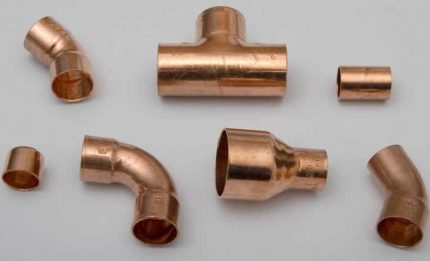
Tools for performing work:
- gas-burner - enough propane;
- pipe expander (calibrator);
- pipe cuttersince metal shears deform the shape of the pipe;
- chamfer;
- devices for cleaning and polishing (fine sandpaper, brushes, rags).
When choosing solder, it is better to dwell on the option with a tin base. In addition to tin, bismuth or silver may be included in the solder. This type is good in that its melting point is much lower than that of copper products.
For more information on solders for brazing copper pipes, see this stuff.
During the soldering process, the solder will assume a liquid state and will be able to hermetically fill the connecting gap, while the copper elements will not respond to high temperature.
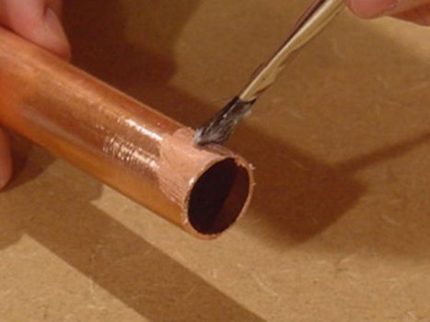
For ease of installation, you can use special fittings for low-temperature soldering. They differ in that at the ends they have a narrow groove filled with solder.
Low-temperature (soft) soldering is typical for domestic work, and high-temperature (hard) is used in production. A hard look is also used when connecting air conditioning pipes and refrigeration units.
Description of the soldering process
Copper is a malleable material, it is not difficult to work with it, but in the absence of experience it is better to first practice on unnecessary pipe sections.
The connection must be allowed to cool and then thoroughly rinse the junction with clean water. If you do not remove the solder residues, over time they will provoke corrosion. It is not recommended to speed up the cooling process with cold air or water, under natural conditions, the compound is cooled for 7-10 minutes.
We also recommend that you read the step-by-step instructions for soldering copper pipes. Read more - read Further.
Safety precautions
Soldering, unlike crimping methods of connection, is a dangerous event, during which it is necessary to use protective equipment. In addition to working clothes made of dense material, it is necessary to wear gloves, as well as glasses with special glasses or plastic.
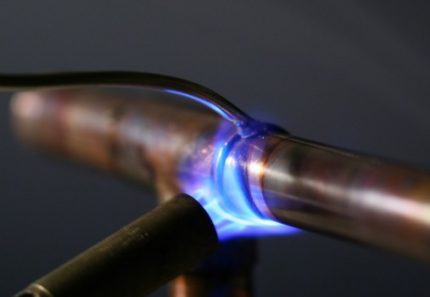
Some types of solders contain fluorine and cadmium, and when the flux is heated, harmful compounds are also released, so for the duration of the operation it is necessary to keep the window open.
Installation Instructions Using Fittings
There are two types of crimp fittings - the so-called pressing and compression. They create completely different connections, so before starting work, you need to decide which connections you would like to see: one-piece or conditionally detachable.
Pressing elements are similar to solder fittings, but have shallow recesses with gaskets at the edges. Using special press tongs, which have a set of nozzles for different diameters, crimping is performed.
As a result, it creates a tight one-piece connection that cannot be repaired, and in case of an accident it is only possible to replace it.
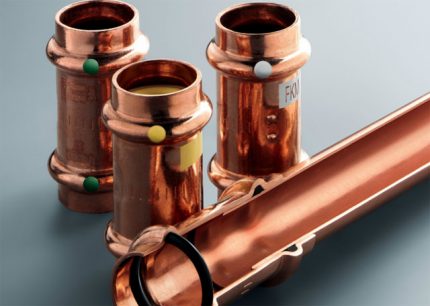
Pressing creates a strong, reliable connection of parts, while maintaining the geometry of the pipes and does not deform the connecting elements. There is a nuance of pressing “soft” copper products: before the operation, a support sleeve is inserted inside the pipe, which resists deformation of the compliant material
The pressing process is simple and does not take much time. From the tool you need a standard set for cutting and processing pipes, as well as press jaws with the right nozzle.
Pressing is considered a reliable method. If you plan to insulate copper pipes, then you can use insulation pipes that are easily worn even on curved structures. After pressing, the finished heating network can be masked in strobes, covered with decorative casing and filled in with a screed.
The second type of fittings is compression. They differ in design and installation process.
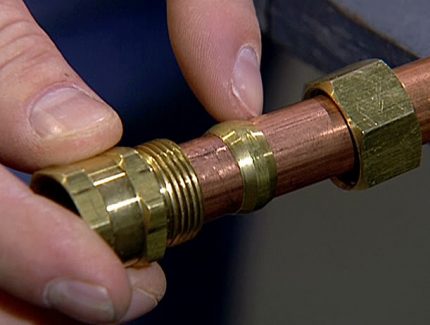
The crimping procedure is as follows:
- a nut is freely thrown on the prepared end of the pipe;
- then a collet is put on;
- Lastly, the fitting body is put on all the way;
- the nut is screwed by hand by thread, while pressing the split ring;
- the connection is reached with an adjustable or adjustable wrench.
During compression crimping, the cutting ring tightly wraps around the pipe, creating a strong and tight joint. The nut may loosen over time, so pipelines with this type of installation must be regularly serviced.
The connections are conditionally detachable, since they can be disassembled, however, if necessary, a fragment with a clamped ring will have to be removed and a new fitting installed.
Conclusions and useful video on the topic
Depending on the location of the pipeline, the diameter of the products and installation conditions, you can choose one or another method. Useful tips on their use are presented in the following videos.
Recommendations for pressing small and large diameter pipes:
How to solder:
Overview of all types of fittings:
Nuances of soldering - practical application:
Each pipe connection method It has its own characteristics, which must be taken into account at the design stage. Crimp technology is seen as simpler, while soldering requires experience and professional skill.
If self-assembly of the pipeline seems complicated, we recommend that you invite a specialist to the assistants and, under his guidance, install the heating network from copper pipes.
If you have the necessary experience and knowledge in the installation of copper pipelines, share it with our readers. Perhaps you know some subtleties of installation that we did not mention in this article? Please leave your comments in the box below.

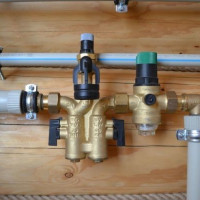 Installation of heating from polypropylene pipes: how to make a heating system from polypropylene
Installation of heating from polypropylene pipes: how to make a heating system from polypropylene 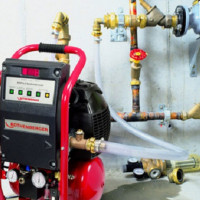 Flushing gas heating systems: flushing methods and procedure
Flushing gas heating systems: flushing methods and procedure  Insulation for heating pipes: overview of types + application examples
Insulation for heating pipes: overview of types + application examples 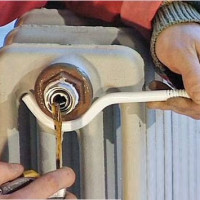 Features of flushing the heating system: an overview of the best ways
Features of flushing the heating system: an overview of the best ways 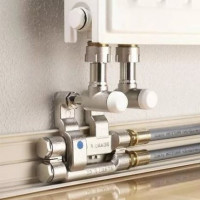 Which pipes are better to choose for heating: a comparative review
Which pipes are better to choose for heating: a comparative review 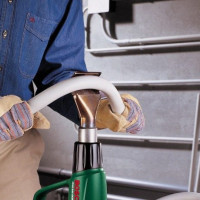 Polypropylene pipes for heating: types, selection criteria, marking
Polypropylene pipes for heating: types, selection criteria, marking  How much does it cost to connect gas to a private house: the price of organizing gas supply
How much does it cost to connect gas to a private house: the price of organizing gas supply  The best washing machines with dryer: model rating and customer tips
The best washing machines with dryer: model rating and customer tips  What is the color temperature of light and the nuances of choosing the temperature of the lamps to suit your needs
What is the color temperature of light and the nuances of choosing the temperature of the lamps to suit your needs  Replacement of a geyser in an apartment: replacement paperwork + basic norms and requirements
Replacement of a geyser in an apartment: replacement paperwork + basic norms and requirements
Copper pipes for heating - a beautiful luxury. Very expensive material and a fairly high cost of installation. If you assemble the system on crimp fittings, then you need to use expensive tools that not everywhere can offer you a rental.
Regarding the term of operation, the installer suppliers themselves will not give you a guarantee of 100 years, as it is written in the article. It must be remembered that copper pipes for heating cannot be combined with aluminum radiators, and cast iron-steel cannot be connected directly to copper.
It is also advisable not to drain the system often, which is difficult to control in a high-rise building. Still, the copper walls are good and fast, especially at the “bends”, they are erased by impurities in the coolant.
If you install a copper heating system in your own house, then you can easily follow all the restrictions, but this is difficult to achieve in apartment buildings - in these cases, other materials are preferable.
Good luck.
Perhaps someone can afford heating pipes made of silver, are there any rich eccentrics? I would like to note one more nuance. In the pictures we see new, beautiful pipes. After some time, they will turn black, covered with a layer of oxide, and they will have to be periodically cleaned to a shine. And who needs it and why? By the way, it will probably be interesting to lovers of vintage style.